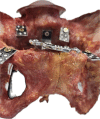Motion preservation for open book injuries of the pubic symphysis -a biomechanical cadaver study
- PMID: 38801533
- PMCID: PMC11211126
- DOI: 10.1007/s00402-024-05390-7
Motion preservation for open book injuries of the pubic symphysis -a biomechanical cadaver study
Abstract
Introduction: Open book injuries are challenging injuries that oftentimes require surgical treatment. Currently, treatment is performed with symphyseal plating requiring extensive surgery and entirely limiting physiological movement of the symphyseal joint, frequently resulting in implant failure. Therefore, we investigated the biomechanical properties of a minimally invasive tape suture construct (modified SpeedBridge™) as an alternative stabilization technique for the treatment of open book injuries in human cadaver pelvic rings.
Materials and methods: The symphysis of 9 human cadaver pelvises was dissected and dilated to 3 cm creating an open book injury. Next, the two osteosynthesis methods (plating, modified SpeedBridge™) were applied. All specimens then underwent cyclic horizontal and vertical loading, simulating biomechanical forces while sitting, standing and walking. For statistical analysis, 3D dislocation (mm) was calculated.
Results: Total displacement (mm) of the pubic symphysis displayed the following means and standard deviations: native group 1.34 ± 0.62 mm, open book group 3.01 ± 1.26 mm, tape group 1.94 ± 0.59 mm and plate group 1.37 ± 0.41 mm. Comparison between native and open book (p = 0.029), open book and plate (p = 0.004), open book and tape (p = 0.031), as well as tape and plate group (p = 0.002) showed significant differences. No significant differences were found when comparing the native and tape (p = 0.059), as well as the native and plate (p = 0.999) group.
Conclusion: While both osteosynthesis techniques sufficiently stabilized the injury, symphyseal plating displayed the highest rigidity. The modified SpeedBridge™ as a tape suture construct provided statistically sufficient biomechanical stability while maintaining symphyseal micro mobility, consequently allowing ligamental healing of the injured joint without iatrogenic arthrodesis.
Keywords: Biomechanics; Flexible osteosynthesis; Minimally invasive; Pelvic instability; Pubic symphysis; SpeedBridge™.
© 2024. The Author(s).
Conflict of interest statement
Adrian Cavalcanti Kußmaul received financial support from the WiFoMed grant and FöFoLe grant of the Ludwig-Maximilians-University Munich. All other authors have no conflict of interest or competing interests.
Figures





Similar articles
-
Novel minimally invasive tape suture osteosynthesis for instabilities of the pubic symphysis: a biomechanical study.Arch Orthop Trauma Surg. 2022 Sep;142(9):2235-2243. doi: 10.1007/s00402-021-03968-z. Epub 2021 May 29. Arch Orthop Trauma Surg. 2022. PMID: 34052913 Free PMC article.
-
Locked versus standard unlocked plating of the pubic symphysis: a cadaver biomechanical study.J Orthop Trauma. 2012 Jul;26(7):402-6. doi: 10.1097/BOT.0b013e31822c83bd. J Orthop Trauma. 2012. PMID: 22183199
-
Tape suture constructs for instabilities of the pubic symphysis: is the idea of motion preservation a suitable treatment option? A cadaver study.Arch Orthop Trauma Surg. 2023 Jun;143(6):3111-3117. doi: 10.1007/s00402-022-04547-6. Epub 2022 Jul 13. Arch Orthop Trauma Surg. 2023. PMID: 35831608 Free PMC article.
-
[Progress in treatment of pubic symphysis diastasis].Zhongguo Xiu Fu Chong Jian Wai Ke Za Zhi. 2014 Feb;28(2):250-4. Zhongguo Xiu Fu Chong Jian Wai Ke Za Zhi. 2014. PMID: 24796204 Review. Chinese.
-
What's New in Percutaneous Pelvis Fracture Surgery?Orthop Clin North Am. 2020 Jul;51(3):317-324. doi: 10.1016/j.ocl.2020.02.010. Epub 2020 May 5. Orthop Clin North Am. 2020. PMID: 32498950 Review.
Cited by
-
Biomechanical analysis of a short femoral stem used in revision total hip replacement of a standard femoral stem.Sci Rep. 2025 Jan 15;15(1):1967. doi: 10.1038/s41598-025-86108-6. Sci Rep. 2025. PMID: 39809964 Free PMC article.
References
-
- Culemann UOHPT (2014) Aktuelle Behandlung Der Beckenringfraktur. Unfallchirurg 145–161 - PubMed
-
- Harrasser N, Eisenhart-Rothe R, Biberthaler P (2016) Facharztwissen Orthopädie Unfallchirurgie
MeSH terms
LinkOut - more resources
Full Text Sources

